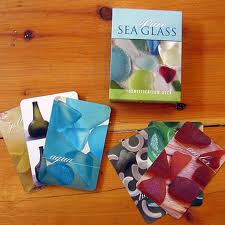Sea Glass FolkloreIn days of yore, when fishing boats sailed the shores of Cape Breton Island, sailors exchanged stories in port, whispering of beautiful and exotic sea creatures.
Word spread of these graceful maidens who swam with ships and held the power of the waves and the luck of the sailors in their hands. The maidens often fell in love with the handsome fishermen, and would do their best to lure them to shore. As the boats drew near they would get caught up in the rocks. The fishermen would die before ever reaching their mermaid maidens. In grief, the mermaids cried tears of glass that still wash up on the beaches of Cape Breton. The beach glass crystaline treasures match the tails of the weeping mermaids, creating magical sea colours as an eternal reminder of true love. |
Colours of the SeaFrom humble origins; the colors of beach glass are as unique as their stories. Broken, turned and polished by the incredible force of the ocean, each piece of glass has it's own age, shape and texture.
Blue: CORNFLOWER BLUE (made 1920s-1950s)Tableware: Phillips' Milk of Magnesia, Noxzema bottles, decorative glass and in late-Depression glass patterns. Finding Ratio: 1 in 500 COBALT BLUE: (1880s-1950s) Bottles , vases and art glass, medicine, poisons, Bromo- Seltzer bottles, Vicks and Noxzema. (1 in 250) SOFT BLUE: (1880s-1930s) Bottles, insulators, windows , tableware, Pop bottles, beer bottles, medicine bottles, jars, window glass and was used by Pepsi long after the 1930s. (1 in 50) AQUA BLUE: (1880s-1930s) Bottles and insulators: common color around the 1900s. Beer bottles, fruit jars, pop, medicines, darker aqua are bottle bottoms and insulators. (1 in 500) TURQUOISE: (1880s-1950s) Tableware, vases, art glass, seltzer bottles (1 in 5000) PASTEL COLOURS: Soft green: bottles and insulators (1890s-1920s) beer, pop and baking powder. Pieces without the ribbed Coca-Cola pattern might be 100 yrs. old. (1 in 50), PINK: tableware, bottles, perfume bottles and art glass (1915-1950) (1 in 1000)GRAY: Tableware and bottles. (1880s-1940s) (1 in 2000) Purple: bottles and tableware. (1880-1915) 1 in 250 YELLOW: Tableware, art glass, stained glass and marbles (1930-1960) Depression glass and Vaseline glass (1 in 3500) BROWN: (1 in 2) (1870s to present), GOLDEN AMBER(1 in 25) (1920-1970) AND AMBER (1 in 25) (1850s to present): Old liquor bottles, medicine, snuff, motor oil, Clorox cleaner, and beer bottles. CLEAR GLASS: (1915 TO PRESENT) many bottles including Cola, medicine bottles, food containers, milk, ( very common) GREEN: Kelly green (1930s to present) 1 in 5: pop and beer bottles and a little tableware. JADE: (1860-present) 1 in 25: bottles such as mineral water, wine. LIME GREEN : (1950s-1970s) 1 in 50: Pop bottles, Depression glass tableware, drug and milk bottles.TEAL: (1870s-1910) 1 in 2000 baking powder, mineral water, ink, wine(before the 1950s). CITRON: (1870s-1920s) 1 in 250 food containers, oils, fruit jars,wine. FOREST GREEN: (1700s-1900s) 1 in 50 Wine bottles, mineral water, and Depression glass. Rare colors include red, yellow, orange, purple, teal and turquoise. Although some glass had started out clear, with many years of sunlight exposure: Yellow glass made with uranium glows neon lemon under a black light; Pink is made from the presence of selenium; Purple with the presence of manganese and gray with traces of copper and iron. TO LEARN MORE ABOUT SEA GLASS SEE SEA GLASS ID CARDS ON: OTHER CREATIONS SECTION. |




